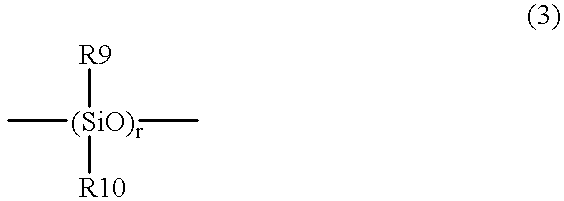Long wearable soft contact lens
a contact lens and long-wearing technology, applied in the field can solve the problems of soft contact lenses, many problems, and physical hardness of hard contact lenses, and achieve the effect of improving wearability and comfor
- Summary
- Abstract
- Description
- Claims
- Application Information
AI Technical Summary
Benefits of technology
Problems solved by technology
Method used
Image
Examples
example 1
[Synthesis of Hydrophilic Siloxanyl Methacrylate]
A solution of 12.4 g of 2-isocyanatoethyl methacrylate in 30 ml of cyclohexane was prepared, then said solution was added dropwisely into a solution of 30 g of tris(trimethylsiloxy)silyl propyloxyethyl alcohol in 50 ml of cyclohexane added with 0.03 g of dibutyltin laurate, followed by reacting for 24 hours at 50° C. After finishing the reaction by confirming disappearance of isocyanate group by an infrared spectrum, the reaction mixture was stirred with adding water, and further stirred with adding 500 ml of n-hexane, then about 1000 ml of saturated aqueous NaCl solution. The organic layer was separated, and dried by adding magnesium sulfate. Removal of the solvent under a reduced pressure gave 32 g of hydrophilic siloxanyl methacrylate shown by the following formula I1:
[Preparation of Lens]
A mixture of 9.5 parts by weight of thus obtained hydrophilic siloxanyl methacrylate, 23.5 parts by weight of tris(trimethylsiloxy)silylpropyl m...
example 2
A transparent polymer was obtained by polymerizing according to the same method as described in the Example 1 except for using 18 parts by weight of hydrophilic siloxanyl methacrylate and 15 parts by weight of tris(tri-methylsiloxy)silylpropyl methacrylate. From the polymer thus obtained, hydrogel soft lenses having 44% of water content and 1.2×107 dyne / cm2 of tensile modulus were prepared. Furthermore, depositions of proteins and lipids were so little as 5 μg / lens and 38 μg / lens, respectively, and Dk value was 60. Water wettability was 20° by the captive bubble method and 560 by the sessile drop method.
example 3
As a hydrophilic siloxanyl methacrylate, a monomer having a fluorosiloxanyl alkyl group shown by the formula (2a) was synthesized similarly to the synthesis method in the Example 1. The monomer obtained was polymerized similarly to the method in the Example 1 resulting in a polymer, from which lenses were prepared similarly to the method in the Example 1. Water content and tensile modulus were 40% and 1×107 dyne / cm2, respectively. In addition, depositions of proteins and lipids were so little as 12 μg / lens and 35 μg / lens, respectively, and Dk value was 65. Water wettability was 20° by the captive bubble method and 57° by the sessile drop method.
PUM
| Property | Measurement | Unit |
|---|---|---|
| Percent by mass | aaaaa | aaaaa |
| Percent by mass | aaaaa | aaaaa |
| Percent by mass | aaaaa | aaaaa |
Abstract
Description
Claims
Application Information
 Login to View More
Login to View More - R&D
- Intellectual Property
- Life Sciences
- Materials
- Tech Scout
- Unparalleled Data Quality
- Higher Quality Content
- 60% Fewer Hallucinations
Browse by: Latest US Patents, China's latest patents, Technical Efficacy Thesaurus, Application Domain, Technology Topic, Popular Technical Reports.
© 2025 PatSnap. All rights reserved.Legal|Privacy policy|Modern Slavery Act Transparency Statement|Sitemap|About US| Contact US: help@patsnap.com



